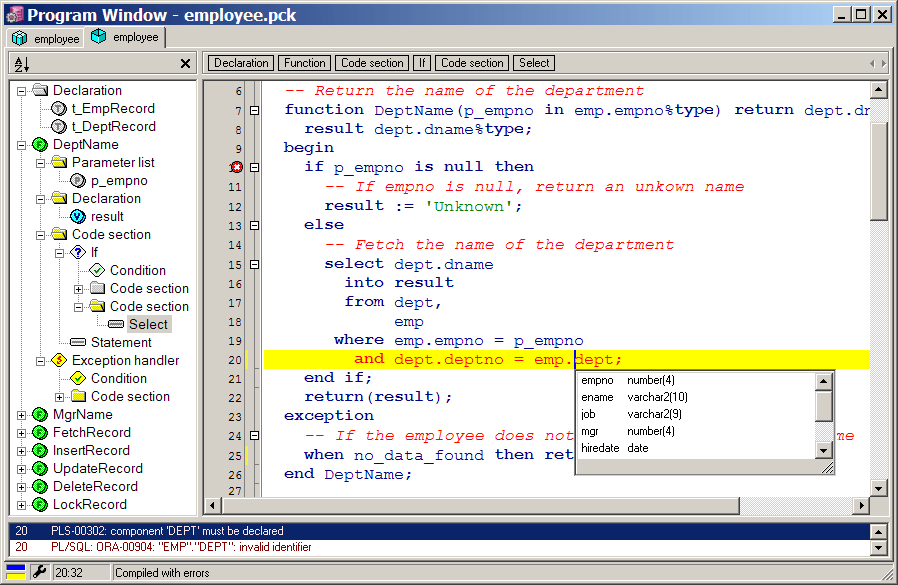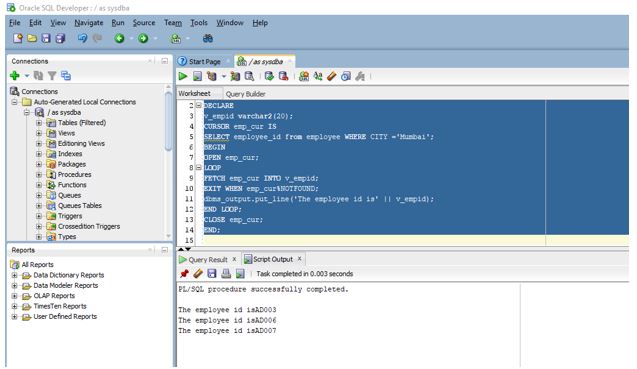

You may use the Full path of the fully accessible directory as C:\>mkdir d:\temp SQL> spool d:\temp\myspoo.txt select * from tab spool off Now you'll get the spool in d:\temp\myspoo.txt to see the current working directory at SQL use host command as SQL>host C:\orant\bin>EXit SQL> You may not be having the write access to C:\orant\bin directory. SET SQLPLUSCOMPAT to 9.2 or earlier to disable the CREATE, APPEND and SAVE parameters. The SPOOL APPEND command does not parse HTML tags. To create a valid HTML file using SPOOL APPEND commands, you must use PROMPT or a similar command to create the HTML page header and footer. You can stop this from happening by using the SET TERMOUT OFF command in your SQL script. The output doesn’t necessarily need to be presented on screen. This will output everything to the file after you issue the command. To start spooling use the SPOOL filename.log command. With SQL Developer: Turn ON the Spool Run the Query Turn OFF the Spool Syntax: The command below only works if you run as Scrip on SQL Developer. Each approach is little different even though the concept is the same. You can spool using SQL Developer or with SQL PLus. How you can spool a result into a file for Oracle database. The SQL SPOOL command syntax is the following: SPOOL filename | OFF | OUT The FileName is the name of the generated file after the spool executes.

In this article, we will check the commands and syntax that can be used in SQL – Oracle SPOOL executions. This playlist gives a quick introduction to the newest member of the SQL Developer family and then deep dives on the Data Modeler, creating and editing objects, and importing data from CSV or Excel. Your CSV file will then get created at your specified path.

In order to execute the Spool in Oracle, you’ll need to run it as a script (for example, if you are using Oracle SQL Developer, you may press F5 to run the Spool as a script).
Oracle sql developer spool how to#
Spool only writes the query output to the file, it doesn't look at the file extension and figure out HOW to write the output at that point. The SERVEROUTPUT setting controls whether SQL*Plus prints the output generated by the DBMS_OUTPUT package from PL/SQL procedures.Set sqlformat csv spool c:\file.sql select * from table spool off then open the file in excel. In addition the output and any system messages will be displayed in the " Script Output" tab. If you type in the command in SQL Developer then the server output will be displayed in the "Dbms Output" tab. This can be done by running the command or by selecting an appropriate menu option. Herein, how do I view a script in SQL Developer?

Alt+PgDn - puts you in Script Output panel. Ctrl+Shift+D, but you have to put focus on the script output panel firstwhich you can do via the KB. Press the "+" button at the top of the Dbms Output window and then select an open database connection in the dialog that opens.Īdditionally, how do I clear a script in SQL Developer? Use cl scr on the Sql* command line tool to clear all the matter on the screen.Show the DBMS Output window (View->DBMS Output).Just so, how do I display output in SQL Developer? Now we can see the panel, but it is empty.First, click on the View menu then select Dbms Output.Let's run the script by clicking the Run Statement button or by pressing F5.


 0 kommentar(er)
0 kommentar(er)
